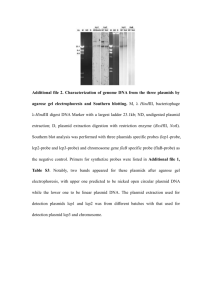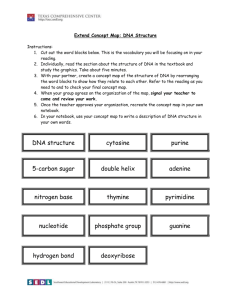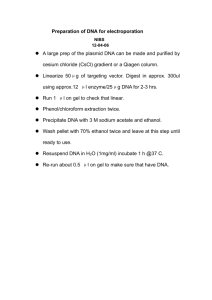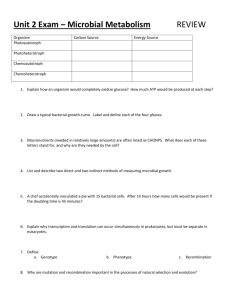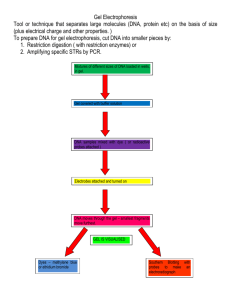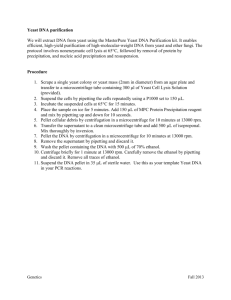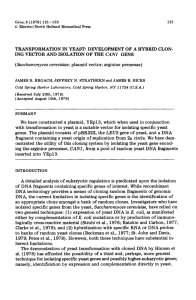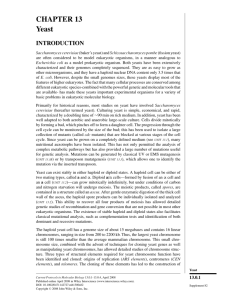Syllabus - University of Pennsylvania
advertisement
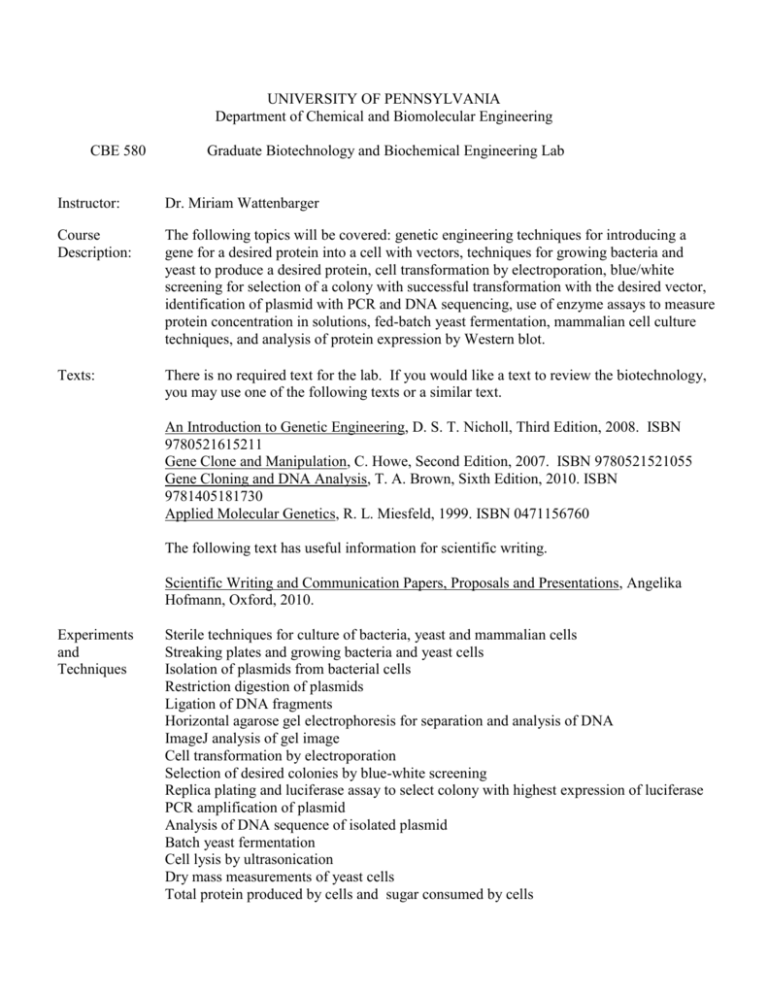
UNIVERSITY OF PENNSYLVANIA Department of Chemical and Biomolecular Engineering CBE 580 Graduate Biotechnology and Biochemical Engineering Lab Instructor: Dr. Miriam Wattenbarger Course Description: The following topics will be covered: genetic engineering techniques for introducing a gene for a desired protein into a cell with vectors, techniques for growing bacteria and yeast to produce a desired protein, cell transformation by electroporation, blue/white screening for selection of a colony with successful transformation with the desired vector, identification of plasmid with PCR and DNA sequencing, use of enzyme assays to measure protein concentration in solutions, fed-batch yeast fermentation, mammalian cell culture techniques, and analysis of protein expression by Western blot. Texts: There is no required text for the lab. If you would like a text to review the biotechnology, you may use one of the following texts or a similar text. An Introduction to Genetic Engineering, D. S. T. Nicholl, Third Edition, 2008. ISBN 9780521615211 Gene Clone and Manipulation, C. Howe, Second Edition, 2007. ISBN 9780521521055 Gene Cloning and DNA Analysis, T. A. Brown, Sixth Edition, 2010. ISBN 9781405181730 Applied Molecular Genetics, R. L. Miesfeld, 1999. ISBN 0471156760 The following text has useful information for scientific writing. Scientific Writing and Communication Papers, Proposals and Presentations, Angelika Hofmann, Oxford, 2010. Experiments and Techniques Sterile techniques for culture of bacteria, yeast and mammalian cells Streaking plates and growing bacteria and yeast cells Isolation of plasmids from bacterial cells Restriction digestion of plasmids Ligation of DNA fragments Horizontal agarose gel electrophoresis for separation and analysis of DNA ImageJ analysis of gel image Cell transformation by electroporation Selection of desired colonies by blue-white screening Replica plating and luciferase assay to select colony with highest expression of luciferase PCR amplification of plasmid Analysis of DNA sequence of isolated plasmid Batch yeast fermentation Cell lysis by ultrasonication Dry mass measurements of yeast cells Total protein produced by cells and sugar consumed by cells Culture of adherent mammalian cells Stimulation of EGFR phosphorylation with EGF Mammalian cell lysis and isolation of total protein Total protein concentration by BCA SDS-polyacrylamide gel electrophoresis Western blot Course Goals: 1. 2. 3. 4. 5. 6. 7. 8. Lab Notebooks: Lab Reports: Understand and carry out the following biochemical laboratory techniques: a. restriction digestion of plasmids b. ligation of DNA fragments c. agarose gel electrophoresis of DNA d. ImageJ analysis of gel image e. isolation of plasmids from cells f. techniques for growing bacteria and yeast on agar plates and in suspension g. cell transformation by electroporation h. blue/white screening for selection of a colony with successful gene insertion i. replica plating j. luciferase assay with microplate reader k. identification of plasmid with PCR and DNA sequencing l. enzyme assays to measure protein concentration m. fed-batch yeast fermentation n. protein isolation and gel electrophoresis of protein from lysed yeast cells o. cell culture techniques for adherent mammalian cells p. analysis of mammalian cell protein expression by Western blot Learn and practice safe handling and disposal of biological materials. Perform calculations to analyze the experimental data obtained. Present the data analysis in tables and figures and explain the results in post-lab assignments. Write reports that present experimental data and analyze the results appropriately in a report that is written according to journal standards. Design a new lab experiment based on techniques learned during the lab and current trends in biotechnology. Prepare a report and deliver a lab presentation on a new lab experiment. Develop teamwork skills in weekly lab work and in preparation and presentation of the final project. Each student is required to keep a complete account of the experiments in a lab notebook. The lab notebook is an important record of the objective, materials, procedures, results, and discussion for each lab. Accurate and complete records of the experiment are essential. The protocol from Canvas may be printed in a small font and taped into the lab notebook, but any changes from the protocol must be noted. Graphs or tables prepared in Excel or Word may be taped into the lab notebook. Additional requirements for the lab notebook will be outlined in a separate handout. The lab notebooks will be collected and graded three times during the semester. Each student will prepare an individual lab report. Group members may discuss the lab and significant results, but the reports must be written without collaboration from group members or other students in the class. The reports will be submitted electronically to Turnitin to check for plagiarism. Electronic or paper copies of the reports can not be shared among students. Students who submit reports that appear to be written with collaboration may receive no credit for the report. Additional specifications for the lab reports will be described in a separate handout. Post-lab Assignments: Post-lab questions will be assigned on most weeks. A typical assignment will be to make a graph of the data collected and describe the results. The assignments will usually be submitted to the Canvas site a few days after the Friday lab. The written parts of the assignment must be prepared by each student with no collaboration from other students. The results presented in the post-lab assignments will be incorporated in the lab reports. Presentation: The semester will end with a presentation from each group on a proposal for a new experiment based on the techniques used in the lab this semester. Group Work: Each lab will be performed by a group of three students. The lab tasks may be divided among the group members, but each student must have a record of all of the procedures in an individual lab notebook. Each group will decide how to share the responsibility for procedures that will be done outside of the scheduled lab period. The analysis, results and discussion may be discussed among the group members, but all written work must be done individually. Please do not write the reports together or discuss the details of the report with anyone enrolled in the lab. You may not share paper or electronic copies of your reports with other students. Group Evaluation: At the end of the semester, each student will assess the contributions of the team members. For a three person group, each group member will have 100 points that may be assigned to the three team members. If all three team members contributed approximately an equal amount of effort, the student may give each person 33 1/3 points. If one group member worked significantly less than the other team members, fewer points may be assigned to that person, but the total points for the team members should add up to 100. The points assigned to the team members for the group evaluation by each student will be submitted to the instructor and kept confidential. The group evaluation points may be used to adjust the final grade for the course. Grading: Lab Reports Post-lab Assignments Lab Notebook Group Project 65% 10% 10% 15%
